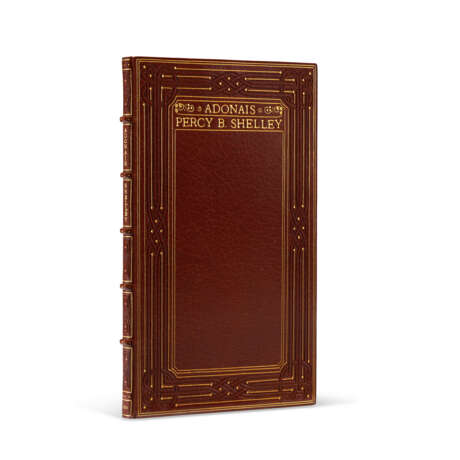ID 813805
Lot 53 | Adonais
Estimate value
$ 15 000 – 25 000
P.B. Shelley, 1821
SHELLEY, Percy Bysshe (1792-1822). Adonais. An Elegy on the Death of John Keats, Author of Endymion, Hyperion Etc. Pisa: With the Types of Didot, 1821.
First edition, printed in Pisa with Shelley's oversight. In a fine Sangorski & Sutcliffe binding. Shelley's moving elegy on the death of John Keats, in ringing Spenserian stanzas, is prefaced by a bitter attack upon the critics of the Quarterly Review, whose harsh treatment of Endymion, Shelley believed, had hastened Keats' death. In June, Shelley had reported to Claire Clairmont that he was at work on the poem, which, he thought, was "better than anything I have yet written, and worthy both of him and of me." Mary Shelley later commented that Adonais was as much Shelley's own elegy as Keats's. Shelley considered it his most finely "wrought" poem and he took special care in its printing in Pisa. It is Shelley's only poem to have a second (London) edition in his lifetime. The book was handsomely printed at the poet's request in Pisa by an unidentified printer, and issued without half-title. The present copy is handsomely bound by Sangorski & Sutcliffe. Granniss 66-68; Grolier English 73; Hayward 229; Wise Shelley, pp. 59-60.
Quarto (208 x 130mm). (Some light spotting, mostly at start, outer margin trimmed.) Full brown morocco by Sangorski & Sutcliffe, covers with strapwork borders in blind, gilt-rules and gilt dots, spine similarly decorated in blind and gilt in six compartments with raised bands, board edges gilt-ruled, turn-ins with double gilt rule and blindstamped and gilt floral cornerpieces, all edges gilt. Custom clamshell box.
| Address of auction |
CHRISTIE'S 20 Rockefeller Plaza 10020 New York USA | ||||||||||||||
|---|---|---|---|---|---|---|---|---|---|---|---|---|---|---|---|
| Preview |
| ||||||||||||||
| Phone | +1 212 636 2000 | ||||||||||||||
| Fax | +1 212 636 4930 | ||||||||||||||
| Conditions of purchase | Conditions of purchase | ||||||||||||||
| Shipping |
Postal service Courier service pickup by yourself | ||||||||||||||
| Payment methods |
Wire Transfer | ||||||||||||||
| Business hours | Business hours
|




